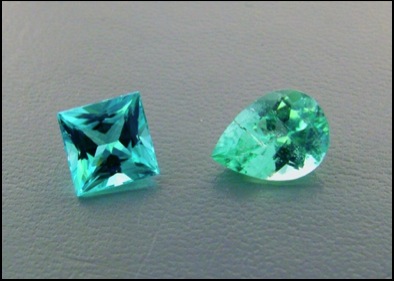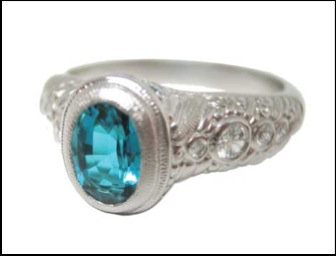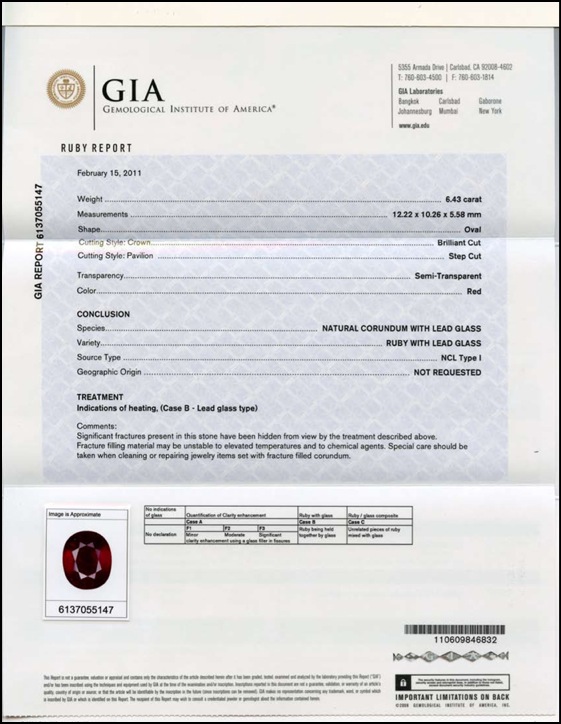

Cuprian tourmalines
The Paraíba tourmaline
controversy
It’s
been more than a decade since the transcendent neon blues
of Brazil’s Paraíba tourmaline first came to market. Like
Tanzanite, Paraíba was named for the area in which it was
mined, a location that has proved to be unique in all the
world. Both of these rare gems have become collectable, and
fine gems of size command princely sums. Traces of copper
and manganese in the molecular structure are responsible
for Paraíba’s stunning color.
Now the term “Paraíba” is
being used to describe other copper-containing tourmalines
from Nigeria and Mozambique, and many in the gem world
aren’t happy about it. These new gems range in color from
shades of robin’s-egg blue to blue-green to green and even
violet. They contain the same ingredients as Paraíba
tourmaline, but in different concentrations. They’re simply
not “Paraíba” in either look or origin, but the sellers of
these stones hope the name’s caché will make their stones
more salable.

Paraíba
tourmaline in Platinum by Alex
Sepkus
Recently
the president of the American Gem Trade Association (a gem
dealer who just happens to have a large inventory of
Mozambique and Nigerian tourmaline), announced that
henceforth the AGTA gem lab would certify all
copper-bearing tourmalines as “Paraíba”, regardless of
origin. He claimed that the AGTA Board had made the
decision, but this proved not to be true. In the face of
outraged opposition, he took a sudden leave of absence and
the AGTA board rescinded the previously announced policy.
The jury is still out on this
issue, but the most recent issue of Gems and Gemology, the
quarterly journal of the Gemological Institute of America,
reported that probable origin of Paraíba-like tourmaline
could now be determined through sophisticated gemological
testing (LA-ICP-MS, see article at right). The
international Laboratory Manual Harmonization Committee,
which includes seven major gemological laboratories, has
for now agreed to apply the term “Paraíba” to all blue,
bluish-green to greenish blue, green and violet albeit
tourmaline that contains copper and manganese, regardless
of its origin. But in this country, the FTC forbids using
place names to describe gems unless the seller can provide
documents to support the claim. Stay tuned–and as always,
CAVEAT EMPTOR.
This month’s sources include the article
“Paraíba-type
Copper-bearing Tourmaline from Brazil, Nigeria and
Mozambique"; and AGTA
member bulletins.
--------------------------------------------
LA-ICP-MS: (Laser
ablation-inductively coupled plasma-mass spectrometry): a
new way to determine origin and detect treatments of
gemstones.
LA-ICP-MS
is an analytical technique used to detect the chemical
composition of gems. It reveals both additives from
gemstone treatments and trace elements that can help
determine a gemstone’s probable geographic origin. And
that’s a good thing.
One of the most troublesome
developments in gemstone enhancement in recent years has
been the large-scale beryllium diffusion treatment of
natural sapphire. This treatment can result in color
enhancement including complete color change in some cases.
(“Rainbow sapphires” are produced by this treatment.)
Unlike previous diffusion
treatments, beryllium diffusion penetrates the entire stone
and is impossible to detect without sophisticated testing.
Originally only the yellow-orange-purple-pink part of the
spectrum was thought to be affected, but we now know that
in all probability, nearly all sapphire undergoes this
treatment, including classic blue sapphire.
In LA-ICP-MS testing, a
minute amount of the gem sample is vaporized by a
high-energy laser beam, and the vaporized material is
ionized into a plasma by a high-frequency power generator.
Even trace elements in the parts per billion range can be
identified. The test leaves a tiny spot on the surface of
the sample, and cut gems are generally tested on the bottom
of the stone in an area that can easily be repolished.
LA-ICP-MS allows gemologists
to definitively diagnose beryllium diffusion and other
treatments. It also makes possible the cataloging of the
precise makeup of gems from specific sources, which may
ultimately solve the dilemma of place-name designations.
This month's sources include "Chemical
Fingerprinting by LA-ICP-MS” by Abduriyim,
Kitawaki, Furuya and Schwarz (Gems and Gemology volume
XLII).
--------------------------------------------
Glass filling
of highly included natural ruby to significantly enhance
clarity
Once upon
a time, a by-product of the routine heat treatment of
rubies was the filling of common small surface inclusions
with residual flux from the crucibles used in the
treatment. Now we are seeing cases where highly imperfect
rubies with significant surface fissures have been filled
with lead-containing glass that transforms their appearance
completely.
The material used is often
very low grade pink, red or purplish Madagascar corundum
but glass-filled stones from Tanzania and Myanmar have also
been noted. The effectiveness of the treatment is amazing
in that it transforms opaque and nearly worthless corundum
into material that is transparent enough for use in
jewelry. However, ammonia, bleach, and even concentrated
lemon juice were found to damage the filler by turning it
white at the surface.
Cavities filled with
high-lead glass can be challenging to see under the
microscope, but most samples recently examined by the
Gemological Institute of America contained gas bubbles and
exhibited a blue or orange flash effect at the interface
between the natural material and the filler. Glass is
significantly softer than ruby, and the filled area may
exhibit an inferior polish to that of the natural ruby
host.
This month's sources include The Loupe and GIA World News
Vol. 15 #3
--------------------------------------------

Buyer
Beware Alert
Glass-filled ruby scam in
Madison, Wisconsin
In January a woman came to Studio Jewelers with a 6.43
carat ruby that her husband had given her for an important
anniversary. She wanted it appraised and set in a custom
ring. The ruby was an attractive red color but quite cloudy
in appearance due to numerous small inclusions. The
customer stated her husband had purchased the ruby from a
man he met socially, and had been told it was a natural
ruby. He had paid $1,500 cash for it and was told he should
insure it “for at least $7,500”. She didn’t identify the
seller except to say he traveled a lot, claimed to be in
the jewelry business and dabbled in selling gemstones.
Because the range of possible value in a large ruby is so
great (depending on whether it’s synthetic, natural, heat
treated, color enhanced by beryllium diffusion, or
fracture-filled) Hanna sent the stone to the Gemological
Institute for certification of origin and treatments. The
GIA found the ruby to be extensively glass filled, which put
its retail value at well under $300.
This scammer was able to take advantage of this couple’s
ignorance of the natural ruby market as well as a common
misapprehension about exorbitant margins in the jewelry
business, implying that a markup of 500% or more would be
normal. The undocumented cash purchase leaves the consumer
little recourse.
For more information on
this topic, please read the above article on glass-filled
rubies
--------------------------------------------